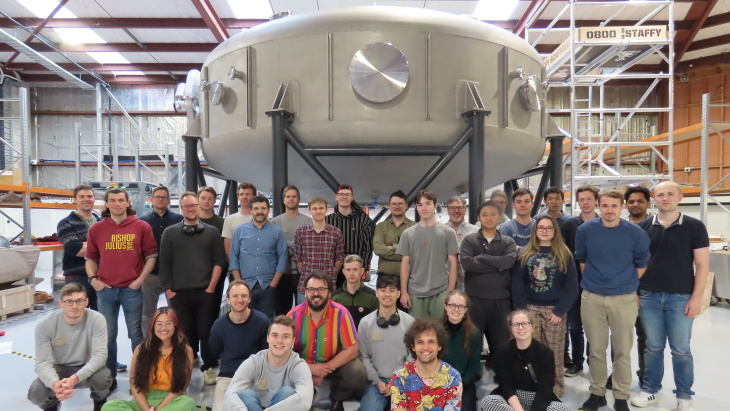The SMART (Small Aspect Ratio Tokamak) is being designed and developed through a collaboration between the University of Seville and the USA's Princeton Plasma Physics Laboratory (PPPL). It benefits from PPPL computer codes as well as the laboratory's expertise in magnetics and sensor systems.
"The SMART project is a great example of us all working together to solve the challenges presented by fusion and teaching the next generation what we have already learned," said Jack Berkery, PPPL's deputy director of research for the National Spherical Torus Experiment-Upgrade (NSTX-U) and the principal investigator for the PPPL collaboration with SMART. "We have to all do this together or it's not going to happen."
Manuel Garcia-Munoz, professor at the Department of Atomic, Molecular and Nuclear Physics of the University of Seville as well as co-leader of the Plasma Science and Fusion Technology Lab and the SMART tokamak project, added: "It needed to be one that a university could afford but also one that could make a unique contribution to the fusion landscape at the university scale. The idea was to put together technologies that were already established: a spherical tokamak and negative triangularity, making SMART the first of its kind. It turns out it was a fantastic idea."
Triangularity refers to the shape of the plasma relative to the tokamak. The cross section of the plasma in a tokamak is typically shaped like the capital letter D. When the straight part of the D faces the center of the tokamak, it is said to have positive triangularity. When the curved part of the plasma faces the center, the plasma has negative triangularity. Negative triangularity should offer enhanced performance because it can suppress instabilities that expel particles and energy from the plasma, preventing damage to the tokamak wall.
According to PPPL, the spherical shape of SMART should make it better at confining the plasma than it would be if it were doughnut shaped. SMART will be the first spherical tokamak to fully explore the potential of negative triangularity.
The collaboration between SMART and PPPL also extends into one of the laboratory's core areas of expertise: diagnostics, which are devices with sensors to assess the plasma. Several such diagnostics are being designed by PPPL researchers.
Researchers at the University of Seville have already run a test in the tokamak, displaying the pink glow of argon when heated with microwaves. This process helps prepare the tokamak's inner walls for a far denser plasma contained at a higher pressure. The first tokamak plasma is expected to be produced by the end of this year.
New Zealand milestone
Wellington-based OpenStar Technologies announced it has taken a crucial step towards completing New Zealand's first fusion energy device prototype. The company successfully powered its core component - a half-tonne doughnut-shaped magnet named Junior - using a patented key-enabling technology called the flux pump.

(Image: OpenStar)
Junior houses a unique, complex arrangement of superconducting systems. When operational, it floats suspended inside a vacuum chamber, which is why it's known as a 'levitated dipole'. This method enabled by the flux pump addresses the core challenge of fusion: reliably replicating the same process which powers our sun. Doing this on Earth requires heating plasma to well over 100 million degrees Celcius to initiate the fusion reaction, where two ions combine while releasing an enormous amount of energy.
Since no physical material can withstand contact with those temperatures, the plasma is suspended in a vacuum, confined by a magnetic field, while fusion occurs. In other fusion machines, plasma is contained inside the superconducting magnets by the magnetic field they produce.
Charging Junior using the flux pump enables it to operate while floating freely without any external power supplies connected to the device, reinforcing the simplicity and strength of the dipole configuration.
Superconductors are housed within Junior, and the magnetic field lines emanate outwards in a dipole shape, confining the plasma around the magnet, echoing Earth's own magnetosphere.
"Besides the physics advantage of pulling instead of pushing on the unstable plasma, the inversion of the magnet on the inside of the plasma has the benefit of having a smaller, replaceable, high-tech core magnet with high utilisation compared to tokamaks and similar devices," said OpenStar Director of Plasma Science Darren Garnier.
"This is the first global, commercial, use of a unique superconducting power supply (flux pump) in a high-field fusion class magnet," said Rod Badcock of the Robinson Research Institute at Victoria University of Wellington. "This NZ technology enables every following step all the way to first plasma for this fusion energy technology. It proves that the unique approach taken by OpenStar is viable."

_70828.jpg)



_23621.jpg)

_63865.jpg)
_18570.jpg)





